B4RN East Anglia Connect First Rural Premises to 1Gbps Broadband
At the end of last year the B4RN East Anglia (B4RNorfolk) ISP began construction of a new community built and funded “hyperfast” Fibre-to-the-Home (FTTH) broadband network for rural villages in parts of Norfolk, Suffolk and Essex (England). Today the first properties have been connected.
Until recently the long-running B4RN (Broadband for the Rural North) project had only focused upon deploying their 1Gbps (Gigabit) capable “full fibre” network to some of the most isolated rural homes in Lancashire, Cumbria and Yorkshire. Such work is normally too expensive for small rural villages but B4RN overcomes this by harnessing local volunteers to help build the network (usually in exchange for shares instead of cash).
However the team had long aspired to expand beyond their current area and in July 2017 they soft launched a new division to do just that: B4RN East Anglia (here). Construction of the new network finally began at the end of December 2017 (here) and their fibre optic cable has now reached the large village of Scole in Norfolk (on the border with Suffolk), which is home to around 1,400 people.
Advertisement
So far in 2018, the Scole community has installed approximately 7kms of duct with the help of B4RN’s engineers. The first property to go live is the Scole Community Centre but locals homes will follow and the team are already in the process of raising enough investment to reach Billingford, Upper Street, Thelveton and Shimpling.
On top of that they’ve confirmed that Gissing, Tivetshalls and Thwaite “are expected to be the next communities to extend the B4RN network.” Gissing and Tivetshalls have already been mapped, costed and are now additionally seeking investment from their respective residents. Many more areas could follow and you can get a rough idea of the initial fibre route (Scole) below.

As usual B4RN’s approach works best for “soft digs” (i.e. building over farm land rather than urban streets) and they hope to have achieved a total of 5,000 UK connections (currently 4,200+) by the end of this summer, which represents actual live users and not “premises passed“. The nature of B4RN’s deployment makes it tricky to give an accurate figure for premises passed, although technically it should be a fair bit higher than 5,000.
Advertisement
We should also point out that B4RN East Anglia may in the future be able to reach some isolated parts of South East Cambridgeshire. Plus they’ve recently launched a new division to help cater for similar rural communities in the county of Cheshire, which is of course called B4RN Cheshire (details).
Clive Blakesley, Chairman of Scole Community Centre, said:
“When I was approached by B4RN and asked if I was interested in hosting the cabinet at the Community Centre, I realised the fantastic opportunity we had been offered. It has the potential to benefit not only the Community Centre and the groups that use it but the whole village, including local businesses and home workers.
Now we have hyperfast broadband – unbelievably fast, something I’d never have thought was possible. Who would have thought a group of volunteers could build their own broadband network? I would like to thank everyone who has been involved in making this happen. Amazing well done everyone!”
David Evans, B4RN East Anglia Regional Director, added:
“A lot of hard work has gone into this day from bringing together our volunteer network, to raising funds and digging around fields to lay the duct, but it is not rocket science – 15 volunteers and a few B4RN Engineers completed the civil works in about 10 working days spread over a couple of months. In return for that hard work we are now part of one of the most modern and fastest rural broadband networks in the world.
The B4RN pure fibre network brings the latest fibre technology directly into people’s homes using light to transmit the signal and not outdated electrical impulses over unreliable old cable networks. The key for rural broadband is not just connecting fast fibre to the ageing copper and aluminium cables (known as Fibre To The Cabinet, or FTTC), as this dramatically slows the speed and does nothing to prevent the constant breaks caused by the current ancient infrastructure.
The answer is to bring a fast, reliable, fibre connection to each property (known as Fibre To The Home, or FTTH), this is what the B4RN community is doing.”
It’s worth pointing out that some nearby homes can already access speeds of around the “superfast broadband” (24Mbps+) level via Openreach’s FTTC network, although B4RN’s FTTH is significantly faster and their strong community engagement has a tendency to result in a fierce level of take-up (average of around 60%).
Customers pay just £30 per month for a 1000Mbps (symmetrical) unlimited service and there’s also a one-off connection fee of £150, which is absurdly cheap when you consider that it’s a Fibre-to-the-Home (FTTH/P) network.
The only issue we have is with the press release’s headline claim of achieving the “WORLD’S FASTEST RURAL BROADBAND NOW LIVE IN EAST ANGLIA,” which is not strictly substantiated. Plenty of other countries have multi-Gigabit capable FTTH networks that have crept into a few rural areas and even Gigaclear in the UK has tested 5Gbps (B4RN would no doubt say they could do 10Gbps if it were in demand). But if we’re entering a realm where the battle is over how many Gigabits you can fit down a single fibre then.. happy days.
Advertisement
One other thing is that the PR attempts to define “hyperfast” as being a “technical term that means typical throughput is greater than 500Mbps“, which does not appear to be officially recognised. We’ve also tended to unofficially associate Hyperfast with 1Gbps+ connections but neither Ofcom nor the government have formally adopted this terminology (instead of Hyperfast it’s more common to just say “Gigabit“).
Mark is a professional technology writer, IT consultant and computer engineer from Dorset (England), he also founded ISPreview in 1999 and enjoys analysing the latest telecoms and broadband developments. Find me on X (Twitter), Mastodon, Facebook, BlueSky, Threads.net and Linkedin.
« 5G Mobile Innovation Network Goes Live to Oversee UK Trials

















































Comments are closed